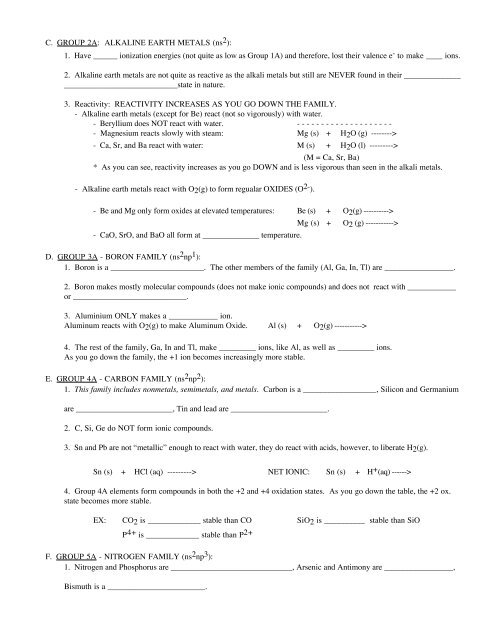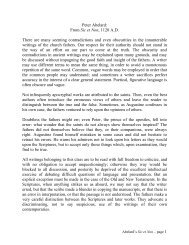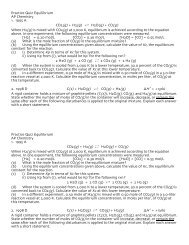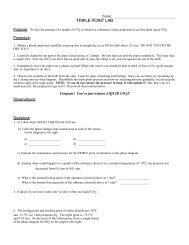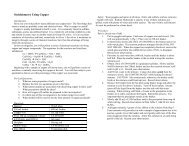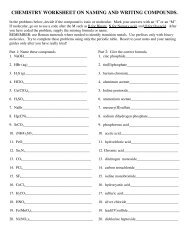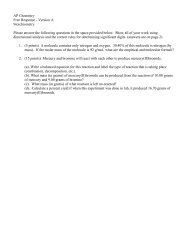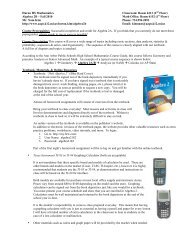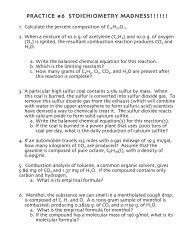Notes#28/Periodic Trends/Variations in Chemical Properties/AP ...
Notes#28/Periodic Trends/Variations in Chemical Properties/AP ...
Notes#28/Periodic Trends/Variations in Chemical Properties/AP ...
You also want an ePaper? Increase the reach of your titles
YUMPU automatically turns print PDFs into web optimized ePapers that Google loves.
C. GROUP 2A: ALKALINE EARTH METALS (ns 2 ):<br />
1. Have ______ ionization energies (not quite as low as Group 1A) and therefore, lost their valence e - to make ____ ions.<br />
2. Alkal<strong>in</strong>e earth metals are not quite as reactive as the alkali metals but still are NEVER found <strong>in</strong> their ______________<br />
____________________________state <strong>in</strong> nature.<br />
3. Reactivity: REACTIVITY INCREASES AS YOU GO DOWN THE FAMILY.<br />
- Alkal<strong>in</strong>e earth metals (except for Be) react (not so vigorously) with water.<br />
- Beryllium does NOT react with water. - - - - - - - - - - - - - - - - - - - -<br />
- Magnesium reacts slowly with steam: Mg (s) + H2O (g) --------><br />
- Ca, Sr, and Ba react with water: M (s) + H2O (l) ---------><br />
(M = Ca, Sr, Ba)<br />
* As you can see, reactivity <strong>in</strong>creases as you go DOWN and is less vigorous than seen <strong>in</strong> the alkali metals.<br />
- Alkal<strong>in</strong>e earth metals react with O2(g) to form regualar OXIDES (O 2- ).<br />
- Be and Mg only form oxides at elevated temperatures: Be (s) + O2(g) ----------><br />
- CaO, SrO, and BaO all form at ______________ temperature.<br />
Mg (s) + O2 (g) -----------><br />
D. GROUP 3A - BORON FAMILY (ns 2 np 1 ):<br />
1. Boron is a _______________________. The other members of the family (Al, Ga, In, Tl) are _________________.<br />
2. Boron makes mostly molecular compounds (does not make ionic compounds) and does not react with ____________<br />
or ____________________________.<br />
3. Alum<strong>in</strong>ium ONLY makes a ____________ ion.<br />
Alum<strong>in</strong>um reacts with O2(g) to make Alum<strong>in</strong>um Oxide. Al (s) + O2(g) -----------><br />
4. The rest of the family, Ga, In and Tl, make _________ ions, like Al, as well as _________ ions.<br />
As you go down the family, the +1 ion becomes <strong>in</strong>creas<strong>in</strong>gly more stable.<br />
E. GROUP 4A - CARBON FAMILY (ns 2 np 2 ):<br />
1. This family <strong>in</strong>cludes nonmetals, semimetals, and metals. Carbon is a __________________, Silicon and Germanium<br />
are ________________________, T<strong>in</strong> and lead are ________________________.<br />
2. C, Si, Ge do NOT form ionic compounds.<br />
3. Sn and Pb are not “metallic” enough to react with water, they do react with acids, however, to liberate H2(g).<br />
Sn (s) + HCl (aq) ---------> NET IONIC: Sn (s) + H + (aq) ------><br />
4. Group 4A elements form compounds <strong>in</strong> both the +2 and +4 oxidation states. As you go down the table, the +2 ox.<br />
state becomes more stable.<br />
EX: CO2 is _____________ stable than CO SiO2 is __________ stable than SiO<br />
P 4+ is _____________ stable than P 2+<br />
F. GROUP 5A - NITROGEN FAMILY (ns 2 np 3 ):<br />
1. Nitrogen and Phosphorus are ______________________________, Arsenic and Antimony are _________________,<br />
Bismuth is a ________________________.


